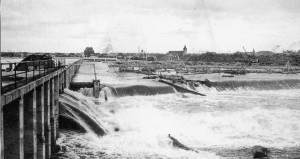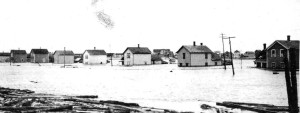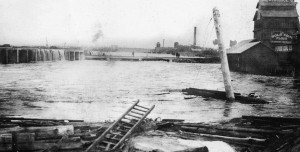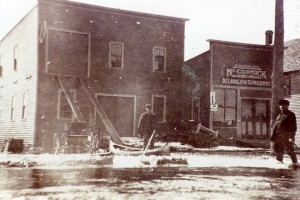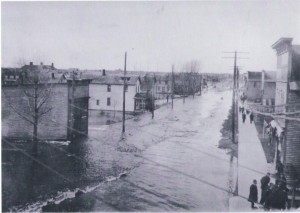The Flood Of 1920-Palm Sunday (March 28th, 1920) Manistique, MI-The most catastrophic event to occur in Manistique other than the fire of 1883 was the flood of 1920. Floodwaters began pouring over the flume walls in the early morning of Palm Sunday, March 28, 1920. The immediate cause of the flood was an ice jam on the Driggs River that backed the river up. When the jam broke, the water and logs in the river rushed into the Manistique River. Since the winter had an exceptional snowfall along with warmer than normal temperatures and several days of rain, the rivers draining into the Manistique River were already swollen. With the torrent of water, a west bank wall broke, causing water to rush over the flume walls and into the west side of Manistique all the way down Deer Street and Chippewa Avenue.
More than $1,500,000 in property damage as many city streets were beneath one to four feet of water. The disaster overwhelms the industrial west side of Manistique, as the Goodwillie Brothers Box factory badly wrecked with loss of 125,000 feet of lumber – Waddell Lumber Company completely wiped out, the paper mill practically destroyed, a lime works, chemical plant and many saw mills badly damaged. Huge piles of timber to be cut into lumber, pulp wood for paper and other wood for chemicals were swept into Lake Michigan and lost. Many homes were ruined leaving dozens of family’s homeless, while twenty more homes under water to the second floor for several days, thereby ruining household effects. Traffic over the city bridge was suspended for over a
week.
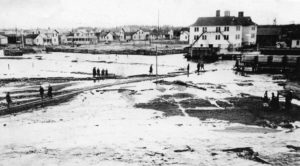
The large building on the right was West Side School
that was located on Chippewa Avenue – which
was several blocks away from the Manistique River.
the School only suffered minor damage as it was built on
higher ground. The railroad tracks where some people
were walking also partially submerged.
The above picture shows one of leaks in the flume walls.
The force of Manistique River is shown as the water poors
Into the Manistique community.
This picture shows homes on Weston Avenue, which
was the closest street to the Manistique River on Manistique’s
west side. Most of the homes had floodwaters rise to their
their second stories within a 24 hour span, thus not allowing
anyone anytime to save any of their possessions.
This picture shows the floodwaters around the Riverside
Coal and Produce Company owned by E.W. Miller. These
buildings were located on the east side of the Manistique
River on East Elk Street. The swift current carried coal,
stocks of grain and other produce into Lake Michigan.
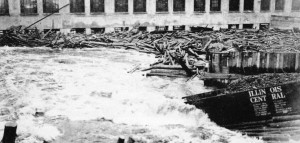
The floodwaters passed through the paper mill breaking
windows and upending equipment. The pulp and paper mill
company garage, containing a truck, storage buildings, and o
other structures were swept into the bay. Fortunately for the
mill, their paper machine was located on the second floor and
sustained no damage. Since the mill supplied power to the
City of Manistique, the poles carrying electricity fell, so power
was out. Temporary electric poles were built and a dike was
was built in front of the generating room, which had also been
under water, so Manistique’s power loss only lasted 12 hours.
The flood of 1920 that flooded the west-side of Manistique.
This picture shows Deer Street (west side of Manistique) with the water swirling down the street. The north side of the street fared better than the south side due to the buildings having built-up walkways and being on higher ground. H. Voisine and Sons owned a storeroom and implement company on Deer Street. Their building contained farm machinery and with the swiftness of the current, it tore away the foundation causing the floors to collapse. As a result, machinery was washed away. The story of stepping on the pickerel also occurred on this street.


